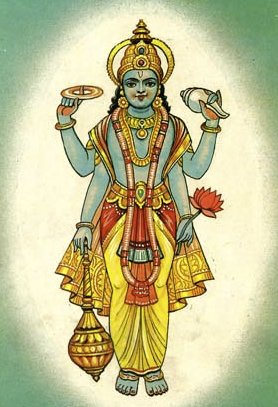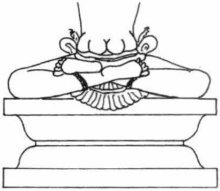Vaishnavagama, Vaishnava-agama, Vaiṣṇavāgama: 6 definitions
Introduction:
Vaishnavagama means something in Hinduism, Sanskrit. If you want to know the exact meaning, history, etymology or English translation of this term then check out the descriptions on this page. Add your comment or reference to a book if you want to contribute to this summary article.
The Sanskrit term Vaiṣṇavāgama can be transliterated into English as Vaisnavagama or Vaishnavagama, using the IAST transliteration scheme (?).
Images (photo gallery)
In Hinduism
Vaishnavism (Vaishava dharma)
Source: Shodhganga: Iconographical representations of Śiva (vaishnavism)Vaiṣṇavāgama (वैष्णवागम) represents one of the three classes of āgamas (traditionally communicated wisdom).—The Vaiṣṇavāgamas preach us the right behaviour, knowledge about the divine states and manner of obtaining them, and about the glory of God and reality (definitions found in this school treat āgama as a śāstra). Vaiṣṇavāgamas are predominantly divided in to two sects, they are Vaikhānasa and Pāñcarātra.

Vaishnava (वैष्णव, vaiṣṇava) or vaishnavism (vaiṣṇavism) represents a tradition of Hinduism worshipping Vishnu as the supreme Lord. Similar to the Shaktism and Shaivism traditions, Vaishnavism also developed as an individual movement, famous for its exposition of the dashavatara (‘ten avatars of Vishnu’).
General definition (in Hinduism)
Source: WikiPedia: HinduismThe Vaishnava Agamas are found into two main schools -- Pancharatra and Vaikhanasas. While Vaikhanasa Agamas were transmitted from Vikhanasa Rishi to his disciples Brighu, Marichi, Atri and Kashyapa, the Pancharatra Agamas are considered to be revealed and handed down in three ways --
- divya, directly revealed by Lord Narayana,
- Munibhaashita, handed down to sages such as Bharadvajasamhita, Parameshvarasamhita, etc.,
- Aaptamanujaprokta, those written by men whose word is trustworthy.
Vaiṣṇavāgama (वैष्णवागम) refers to one of the classifications of the Āgamas (“those texts which clearly give mankind the guidelines and means to lead a fruitful, progressive and meaningful life”).—The Vaiṣṇava Āgamas which enjoin the exclusive worship of Viṣṇu are of two kinds—Vaikhānasa and Pāñcarātra. In the Vaikhānasa school, worship is performed in the sacred fire by reciting the Vedic mantras. In this school of Vaishnavism , people are not required to qualify themselves through training to perform worship. Pāñcarātra is so called because it comprises the discourses delivered by Lord Nārāyaṇa to five deities—Ananta, Garuḍa, Viṣvaksena, Brahmā and Rudra.
Languages of India and abroad
Sanskrit dictionary
Source: Cologne Digital Sanskrit Dictionaries: Aufrecht Catalogus CatalogorumVaiṣṇavāgama (वैष्णवागम) as mentioned in Aufrecht’s Catalogus Catalogorum:—Taylor. 1, 445.
Source: Cologne Digital Sanskrit Dictionaries: Monier-Williams Sanskrit-English DictionaryVaiṣṇavāgama (वैष्णवागम):—[from vaiṣṇava] m. Name of [work]
Sanskrit, also spelled संस्कृतम् (saṃskṛtam), is an ancient language of India commonly seen as the grandmother of the Indo-European language family (even English!). Closely allied with Prakrit and Pali, Sanskrit is more exhaustive in both grammar and terms and has the most extensive collection of literature in the world, greatly surpassing its sister-languages Greek and Latin.
Kannada-English dictionary
Source: Alar: Kannada-English corpusVaiṣṇavāgama (ವೈಷ್ಣವಾಗಮ):—[noun] the science or technical details of construction of Viṣṇu temples, carving and worshipping of Viṣṇu idols.
Kannada is a Dravidian language (as opposed to the Indo-European language family) mainly spoken in the southwestern region of India.
See also (Relevant definitions)
Partial matches: Vaishnava, Agama.
Ends with: Vaikhanasavaishnavagama.
Full-text (+218): Bharadvajasamhita, Agama, Pancarattiram, Vaikhanasavaishnavagama, Katyayana, Satya, Satyasamhita, Shriprashnasamhita, Katyayanasamhita, Ardhacitra, Antahsushira, Bharadvaja, Durvasa, Ahirbudhnya, Dattatreya, Nalakubera, Sanaka, Padmodbhava, Khagaprashna, Pancaprashna.
Relevant text
Search found 6 books and stories containing Vaishnavagama, Vaishnava-agama, Vaiṣṇavāgama, Vaisnava-agama, Vaisnavagama, Vaiṣṇava-āgama; (plurals include: Vaishnavagamas, agamas, Vaiṣṇavāgamas, Vaisnavagamas, āgamas). You can also click to the full overview containing English textual excerpts. Below are direct links for the most relevant articles:
Parama Samhita (English translation) (by Krishnaswami Aiyangar)
Kashyapa Shilpa-shastra (study) (by K. Vidyuta)
5.2. Classification of the Āgamas < [Chapter 1 - Introduction]
2 (a). Literary Evidence to Art-Activity < [Chapter 1 - Introduction]
Diaspora of Bhuta (Daiva) worshipping cult—India and Indonesia (by Shilpa V. Sonawane)
Part 4 - Agama Hinduism followed by Hindus in Bali Indonesia < [Chapter 4 - Inter-Disciplinary Analysis]
Shakti and Shakta (by John Woodroffe)
Chapter XXII - Vedānta and Tantra Śāstra < [Section 3 - Ritual]
Chapter III - What are the Tantras and their significance? < [Section 1 - Introductory]
Temples in and around Madurantakam (by B. Mekala)
Celebrations of various Festivals < [Chapter 5 - Pujas and Festivals]
The Agni Purana (by N. Gangadharan)
